A review of all the verb tenses in English
ABA English Masterclass: Your one-to-one online English class
The Present Tenses
In English, there are four forms in the present tense: the present simple, the present continuousalong with two other particular forms: the present perfect, and the present perfect continuous
Present simple
This is formed using the infinitive verb without the “to“. The suffix -s must be added in third person singular. This tense is used to show
- Habitual actions
I study English every Friday.
- Facts and conditions that do not change
The sun rises at 6 a.m.
Present continuous
Formed with the auxiliary verb ‘to be’ in the simple present + the principal verb with the suffix -ing.
It is used to show:
- An action that is taking place in the moment in which the sentence is spoken.
It is raining.
- Scheduled actions or future events.
Are they coming next summer?
- Continuously repeated actions, generally accompanied by adverbs like always , often , all the time , constantly
Giulia and Robert are constantly arguing.
Present perfect
This is formed by using the auxiliary verb ‘to have’ in the present tense (have/has) + the past participle of the main verb. It is used to indicate:
- An action that began in the past and is still ongoing or that has been taking place over a period of time and which has not yet ended.
I have read over 25 books this year.
I have lived in London since 1991.
- An action or event that occurred in the past, but whose effects are still evident.
I am not ready for my exams. My health has not been good this year.
- An action that has just ended, expressed using the adverb just
I have just finished my homework.
Present perfect continuous
Formed using the present perfect + the participle of the main verb. It is used similarly to the present perfect, with the difference that in this case the focus is not only on the result of the action, but also in its development. It shows:
- An action initiated in the past that continues in the present.
She has been working all day.
- An action that has just finished, but whose results are still present.
It has been raining all day.
The Past Tenses
In English, there are four past tense forms past simple, past continuous, past perfect, past perfect continuous.
Past simple
This is formed using the verb base + the suffix ed, or, in the case of an irregular verb, the appropriate form. It shows:
- An action that happened in the past and which ended definitively and permanently.
Christopher Columbus discovered America in 1492.
Past continuous
Formed using the past tense of the auxiliary verb “to be” (was/were) + the present participle of the principal verb. It is used for an action perceived as unfinished or in progress in the past. It shows:
- A description of a context in which a past event occurred.
The sea was shining and the seagulls were flying when Julio decided to take the boat out.
- An action interrupted by another event or action.
I was taking a shower when the phone rang.
Past perfect
Formed with the past tense of the verb ‘to have’ (had) + the past participle of the principal verb. This tense is used for an event that took place before another event in the past.
- The movie had already started when we arrived.
Past perfect continuous
This verb tense corresponds to the present perfect continuous but in the past. In this case as well, the emphasis is on the progress of the action instead of on its completion. It is formed using the past perfect of the verb ‘to be’ (had been) + the present participle of the principal verb. It shows:
- An event or an action that started before another event or action in the past.
Had you been waiting for long before the train arrived?
The Future Tenses
The future tense also has four verbal forms: future simple (two forms), the future continuous and the future perfect.
Future simple (will)
The future simple is formed using will/shall + the base form of the verb. It expresses:
- A spontaneous decision.
I will call you back later.
- A prediction of a future event.
It will snow tomorrow.
Future simple (going to)
Formed using the auxiliary ‘to be’ in the present simple + going + the infinitive of the principal verb. This is used to show plans or decisions, in particular for future events strongly associated with the present.
- I am going to have dinner with my cousin tonight.
Future continuous
Formed using the simple future of ‘to be’ + the present participle. It indicates a future action that is in development.
- At this time next year, I will be going on holiday.
Future perfect
The future perfect is made up of two elements: the future simple of the verb ‘to have’ (will have) + the past participle of the principal verb. It is used for an action that will be completed in the future time indicated.
- By December, I will have written my thesis.
Future perfect continuous
The future perfect continuous consists of two elements: the future perfect of the verb ‘to be’ + the present participle. It shows that an action will continue into the future and that it will be completed in the future or interrupted by another event.
- I’ll have been studying English for three months this summer.
These are the characteristics of English verbs. As you can see, they are not that difficult, but only take a bit of practice. The ideal way to learn to use verbs without making mistakes is by taking a good English course. ABA English currently has around 17 million students. It offers you an innovative and effective learning method which can adapt itself to the needs of each student. In fact, you have at your disposal 144 free video classes that you can watch at any time, as well as short films and qualified native teachers. What are you waiting for? Become an ABA English student today.
WHY CHOOSE ABA ENGLISH?
ABA English is your best option if you want to learn English at your own pace with an online course. You can use the device of your choice – a PC, mobile phone or tablet – and follow a tailor-made study plan. Set yourself a goal and go for it. A teacher will be there for you from day one to help you achieve your goal.
It doesn’t matter what your level is. You can start at the beginning with our Beginners level and reach our Business C1 level. Every time you complete a level, you will receive an official ABA English certificate which you can share on LinkedIn.
We have an exclusive and effective method for you, based on an appealing and exciting learning experience. We know you won’t see results if you aren’t interested, and so you will start all our units by watching a short film, an ABA Film.
Register FOR FREE and try it. Find out why over 25 million students have chosen to learn English with ABA English. Join us!




